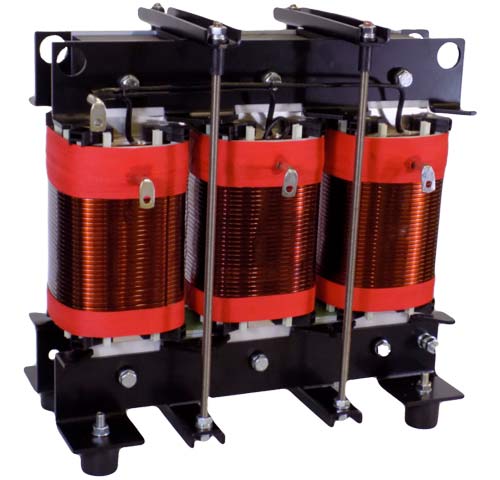The inductive elements present in reactive power compensation devices are the main source of start of active power of compensators. The use of modern technological solutions in the production process of chokes determines the economic efficiency of reactive power compensation. TRAFECO Sp. J. is a manufacturer of low-loss, 3RTC type compensation chokes and 3RTR type resonant chokes intended for use in reactive power compensation devices.
Actual costs of inductive components
The actual cost of compensation chokes includes investment and operating components. The investment part of the cost used by producers during market play is the choke price, which is a small element of the total cost. Hidden or insufficiently articulated is the cost of operating inductive components as a direct result of their design. The inductive chokes present in compensation devices determine their efficiency, as they are the main source of starting power in the device. Reducing the excessive real starting power of chokes not only influences the durability and reliability of the compensation device, but above all improves the economic result of the entire compensation process.
The drive to reduce the price of inductive components is pushing manufacturers to further simplify choke designs. This results in low-quality inductive components with high losses, in which the dynamics of the incremental loss with the appearance of higher current and voltage harmonics in the circuit is very high. The additional losses in such structurally and technologically simplified inductive components increase very quickly and are often the cause of damage or incorrect operation of compensation devices. Table 1 shows a comparison of the total cost of a 50kvar compensation choke, in classic and low loss design. It has been assumed that the choke operates 12h/day and the energy price is PLN 0,7/kWh. Reducing losses significantly reduces large operating costs, which over a period of several years are three times the purchase price of the choke. Making a low-loss compensation choke entails an increase in investment costs, by 25%, which adds up to about PLN 2,000. The low-loss choke design, however, allows to reduce operating costs by nearly 30%, i.e. in the five-year operating period we save nearly PLN 7,700. As you can see, operating costs are large energy losses that must be taken into account when balancing the planned savings from reactive power compensation.

3RTC type, low loss compensation choke with CorECOTM multi-slot technology core to reduce losses.
Low-loss resonance and compensation chokes
Compensation chokes and resonance chokes (Fig. 2 ), as elements of compensation devices, operate under very different conditions depending on the parameters of electricity at the point of connection to the network [1].
Choke losses depend strongly on the harmonic content of the choke current. During the calculations it is extremely important to correctly determine the harmonic spectrum of the current in the choke circuit and the amplitudes of these harmonics according to the actual operating conditions.
Only if the real shape of voltage and current is adopted for the design, the choke will work correctly, achieve the assumed temperatures and the calculated losses will be confirmed during operation. [2.3]. It is a good idea to perform measurements of the electrical parameters at the planned choke location, which will allow the operating conditions of the inductive components to be determined unambiguously and without error.
In a choke winding where harmonic currents of relatively high frequencies flow, a skin effect as well as proximity effect occur . These phenomena have a significant impact on the value of losses in the windings of chokes and their understanding allows the correct planning of the cable layout. The skin effect induces current flow only in the surface layer of the conductors and the thickness of the conductive layer decreases with increasing frequency.
The skin effect is reduced by using windings wound with a bundle of parallel insulated wires. The cross-section of a single wire in a bundle is defined according to the depth of current penetration at the surface of the wire. The current penetration depth (1) depends on the frequency (f), magnetic permeability (μ, μo, μr) and conductivity (σ) of the conductor [4].
The losses in the magnetic core of the choke consist of the basic hysteresis and eddy current losses and additional losses related to the scattering flux, occurring mainly in areas of discontinuity in the core. Reducing eddy current losses by bundling the core with thin insulated sheets in the case of chokes is insufficient. In the gap areas, there is a change in the direction of the flux, which generates additional eddy current losses in the core material, the winding and in the conductive components.
Magnetic and magnetostrictive forces occur in a periodically remagnetised magnetic core. The magnitude of the magnetic and magnetostrictive forces depends on the maximum local magnetic induction values in the core. The acting forces induce varying stresses in the core sheets, resulting in vibration of the structural components and an acoustic field around the choke. CorECOTM is a low-loss technology for assembling and bundling multi- slot choke cores, which enables a drastic reduction of a start in the core while reducing the intensity of the acoustic field around the choke [5]. Loss reduction is achieved by using multiple narrow slots and optimising their placement [6,7].
Download PDF
M. Łukiewski – Urządzenia dla Energetyki 7/2017


